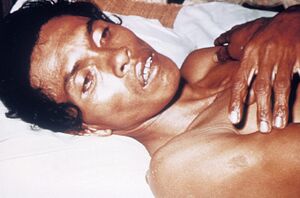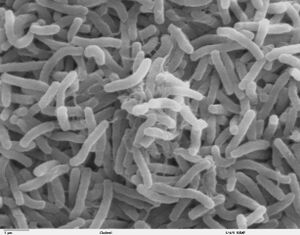Cholera
Cholera is an infectious disease caused by the bacterium Vibrio cholerae , whose incubation period is 12-72 hours. Today, cholera is mainly endemic in southern and south-eastern India, in poor sanitation areas and in developing countries.
History and spread of cholera[edit | edit source]
Cholera patient. Laundry hands caused by reduced skin turgor as a typical symptom of dehydration caused by cholera.
Vibrio cholerae in an electron microscope.
A total of six cholera pandemics took place during the 19th and 20th centuries. Along with the development of transportation, it spread from the Ganges Delta and killed millions of people around the world. The infection was transmitted by the fecal-oral route and the source was mainly water contaminated with pathogenic strains. The current (seventh) cholera pandemic, caused by the El Tor tribe , originated in Indonesia and began in 1961. Cholera still persists in many countries around the world, but especially in poor, densely populated areas. The El Tor tribe is responsible for most diseases. In 2011, the World Health Organization (WHO) recorded 589,854 cases in 58 countries, including 7,816 deaths. However, the actual number of patients is estimated to be much higher, around 3-5 million patients and 100-120,000 deaths per year.
Etiological agents[edit | edit source]
The causative agent of the disease is the gram -negative rod -shaped bacterium Vibrio cholerae. Today, more than 200 species of these bacteria are known, but only species O1 and O139 are able to cause disease. Vibrio cholerae is classified according to phenotypic characteristics into two biotypes - classical and El Tor . El tor biotype disease is more often asymptomatic than in classical bacterial disease.
Epidemiology[edit | edit source]
Vibrio cholerae lives in the wild in relation to some species of algae and zooplankton, it occurs mainly in slow-flowing rivers of the subtropical and tropical zones. The disease occurs by ingesting infected water or food - oysters and other seafood, fruits and vegetables washed in infected water, etc. The source of the infection can also be a person who eliminates vibrations during the disease and for several weeks after the diarrhea has subsided . An individual can become infected by the direct fecal-oral route, however, due to the large infectious dose, indirect transmission from contaminated water in which bacteria have multiplied is more common. A certain John Snow from England discovered that Vibrio cholerae was transmitted by water. He observed the habits of several families whose members contracted cholera. He found that they were using the same well and removed the handle from the pump, thus preventing the spread of infection. John Snow is considered the founder of epidemiology. In the Czech Republic, cholera occurs only as a rare imported disease. Its incubation time depends on the infectious dose (12-72 hours).
Pathogenesis[edit | edit source]
Vibrio cholerae are non-invasive bacteria , they multiply in the small intestine , they do not penetrate the intestinal wall. The main factor in their pathogenicity is the cholera toxin ( enterotoxin ) they produce. Choleratoxin consists of the A subunit and the five B subunits. The B subunits form a circle that allows attachment to the small intestinal epithelium. After binding, the whole complex is endocytosed, part A of the subunit is released and triggers intracellular processes - it blocks Gi-protein and thus overactivates adenylate cyclase . The resulting excess of cAMP leads to a reduction in sodium and chloride resorption and stimulation of chloride and water secretion into the intestinal lumen. Diarrhea and in some cases vomiting therefore arise due to the influence of transport mechanisms for ions and water, the intestinal mucosa is without histological signs of inflammation.
Clinical picture[edit | edit source]
Cholera can be completely asymptomatic, but it can also be moderate to severe. In the case of a moderate form, it is difficult to distinguish it from other diseases caused by intestinal pathogens. With a severe course of the disease, dehydration occurs very quickly (within a few hours) - cholera is easily recognized in this way, because no other infection causes significant dehydration so quickly. Cholera is characterized by a sudden onset with watery diarrhea that is not accompanied by abdominal cramps or tenesms . Repeated vomiting without nausea sometimes precedes diarrhea. Stools and vomit of rice water with mucus flakes are typical. Rarely, the so-called cholera sicca also occurs, when watery diarrhea is missing, distension of the intestine and ileus dominate.
Diagnostics[edit | edit source]
Cholera must be considered in people who come from endemic areas and suffer from acute diarrheal disease without concomitant inflammatory symptoms - body temperature and inflammatory indicators are normal or slightly elevated, stool is free of blood or pus. Cholera occurs in India, Southeast Asia and sub-Saharan Africa (eg Congo, Sudan). The disease is diagnosed by stool cultivation, it is necessary to inform the microbiological laboratory about the suspicion of cholera, otherwise the detection of Vibria cholerae may fail during normal sample processing.
Therapy[edit | edit source]
Classic approach[edit | edit source]
The treatment of cholera is not complicated, it is based on rehydration and mineral therapy of the patient. In case of mild dehydration, oral administration of fluids is sufficient, in case of moderate and severe dehydration we choose intravenous substitution. Antibiotics are given according to the severity of the infection. With adequate hydration, they are not necessary, but they alleviate the symptoms, shorten the time of treatment and the time of excretion of the microbe in the stool, and thus prevent the spread of infection. The most commonly used antibiotics include tetracycline , cotrimoxazole, fluoroquinolones , gentamicin (must not be used during pregnancy!). Over the last two decades, however, many antibiotics have been used in most strains of Vibrio choleraedeveloped resistance in endemic areas. This fact has led scientists to research new substances suitable for the treatment of cholera. If cholera is suspected, isolation in the infectious compartment is necessary.
Inhibition of virulence by natural products[edit | edit source]
Research has shown that another option is to use herbal extracts, spices, fruits and other natural products to treat cholera. Some natural substances effectively inhibit the production of cholera toxin, others reduce its activity or inhibit the growth of bacteria. Substances that are readily available in endemic countries were selected for the research. Methanol extracts from red chili peppers, sweet fennel, white pepper, red pepper, cinnamon and anise were tested on four different strains of Vibrio cholerae El Tor . All the spice extracts used showed a high degree of inhibition of cholera toxin production. The best results were obtained with extracts of red chilli, sweet fennel and white pepper (inhibition of more than 80% of cholera toxin production). The effect on bacterial growth has not been demonstrated.
Red chilli, which is the best available of the given raw materials in endemic areas, was selected for further research. The aim of the research was to isolate a substance that is responsible for inhibiting cholera toxin production. This substance was found to be capsaicin (N-vanillyl-8-methyl-nonenamide). However, the chilli extract showed a higher rate of inhibition of cholera toxin production than capsaicin alone, suggesting the possibility of other compounds contained in the chilli that act as capsaicin synergists. Another advantage of chilli, capsaicin or similar extracts is that they do not have negative effects on the physiological flora of the human gut.
Prevention[edit | edit source]
Sufficient hygiene is the prevention of the disease . Vibrio is a relatively hardy bacterium that is sensitive to drying, disinfection and boiling above 60 ° C.
Links[edit | edit source]
[edit | edit source]
- Rod Vibrio
External links[edit | edit source]
- Cholera (Czech wikipedia)
- Cholera (English wikipedia)
- The Story of Cholera (video with English subtitles on youtube.com)
References[edit | edit source]
- BENEŠ, Jiří. Infectious medicine. first edition. Prague 5: Galén, 2009. ISBN 978-80-7262-644-1 .
- YAMASAKI, S, M ASAKURA and SB NEOGI, et al. Inhibition of virulence potential of Vibrio cholerae by natural compounds. Indian J Med Res. 2011, vol 133 Feb, pp. 232-9, ISSN 0971-5916 (Print), 0971-5916 (Linking). PMID: 21415500 .
- JULÁK, Jaroslav and Emil PAVLÍK. Medical microbiology for dentistry. 1st edition. Prague: Karolinum, 2010. 443 pp. ISBN 978-80-246-1792-3 .
Reference[edit | edit source]
- ↑ Scattered, Hanuš. . Basics of infectious medicine. - edition. Charles University in Prague, Karolinum Press, 2015. 572 pp. 465. ISBN 8024629321 .
| Intestinal infections | |
|---|---|
| In general | Differential diagnosis of diarrheal diseases • Enterotoxicosis • Diarrheal diseases in childhood • Drug-induced diarrhea • Therapy of diarrheal diseases |
| Bacterial | Alimentary poisoning B. cereus • Typhoid fever • Clostridial colitis • Cholera • E. coli colitis • Infection with non-cholera vibrations • Campylobacter enteritis • Paratyphous • Salmonella enteritis • Shigellosis • Staphylococcal enterotoxicosis • Yersiniosis |
| Viral | Adenovirus enteritis • Coronavirus enteritis • Norovirus enteritis • Rotavirus enteritis |
| Parasitic | Amoebiasis • Ascariasis • Enterobiosis • Giardiasis • Hymenolepiosis • Cryptosporidiosis • Teniosis • Toxoplasmosis • Trichinellosis • Trichuriosis |
| Portal: Infectious Medicine | |


